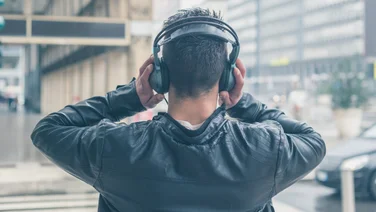To help us provide you with free impartial advice, we may earn a commission if you buy through links on our site. Learn more

By the time wheels lift off the tarmac, most seasoned travellers know the drill: seatbelt fastened, Airplane mode engaged, safety briefing ignored, and headphones firmly in place.
Whether you’re escaping into a film, drowning out the engines with active noise cancellation, or simply cueing up a favourite album, podcast or audiobook to pass the time, your headphones are crucial to the in-flight experience.
Airlines may still offer those fragile, plastic headsets, but the truth is your own headphones are almost certainly the better option. However, using them can be complicated…
Why airline headphones don’t cut it
Why are airline headsets so bad? The simple answer is, they don’t need to be any good. Designed purely to survive at a price, they rarely offer the kind of fidelity or comfort your ears are accustomed to.
Thin, tinny, and lacking detail, they’re as far from high fidelity as it’s possible to get.
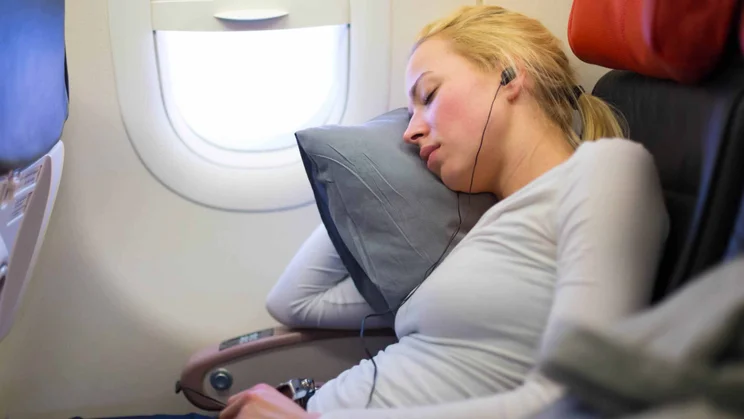
Even worse, their passive design means they’ll do nothing to drown out the relentless drone of the engines or the crying infant two rows back.
And then there’s hygiene. They may be forensically scrubbed, but they’re still endlessly recycled. Reason enough for most of us to pack our own.
Understanding airline audio connections
When it comes to getting your headphones to work with in-flight entertainment systems, it helps to know how to connect them. The majority of airlines use a standard 3.5mm stereo jack for in-flight entertainment. Some carriers, particularly those flying older aircraft, still use a twin-pin connector system.
Deliberately obtuse, to combat theft and simplify wiring, these early in-flight stereo audio systems split the left and right audio signals into two separate jacks. Helpfully, even today, over-ear and on-ear headphones (like the Sony WH-1000XM4 pictured below) are typically sold with a dual-prong adapter in the case. You just have to remember to pack it.
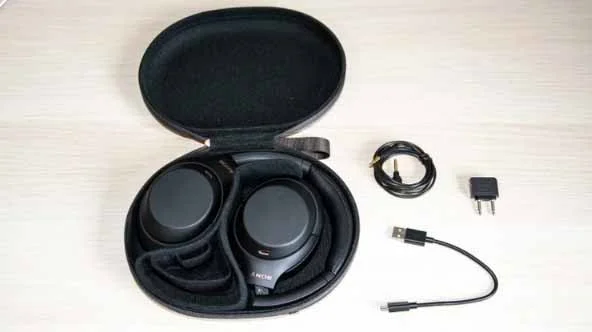
Given they’re inexpensive and available online, it may well be worth buying a spare to keep in your carry-on, just in case.
The wireless conundrum (and the workaround)
But who wants cables anyway? Wireless Bluetooth headphones are the norm on terra firma, and slowly, in-flight systems are beginning to catch up with Bluetooth connectivity. You just have to pick the right airlines.
Jiayi Wang is a travel junkie, professional photographer, and founder of travel website The Diary of a Nomad. She recommends a little research before setting off for the airport.
“Over time, I’ve watched in-flight entertainment break free from the headphone jack, and I recommend taking full advantage of the change,” she told me.
“On newer aircraft from Singapore Airlines and Emirates, you can pair your own Bluetooth headphones directly with the seatback screen. The pairing takes seconds, leaves no wires dangling across your lap, and gives you the clarity of devices you already trust.”
When flying Lufthansa or Qantas, Wang switches to wireless streaming through the airline’s entertainment portal on her phone or tablet. “The cabin instantly feels less cluttered when everyone uses personal screens, and the touch controls are familiar, so there is no fumbling with an unfamiliar remote.”
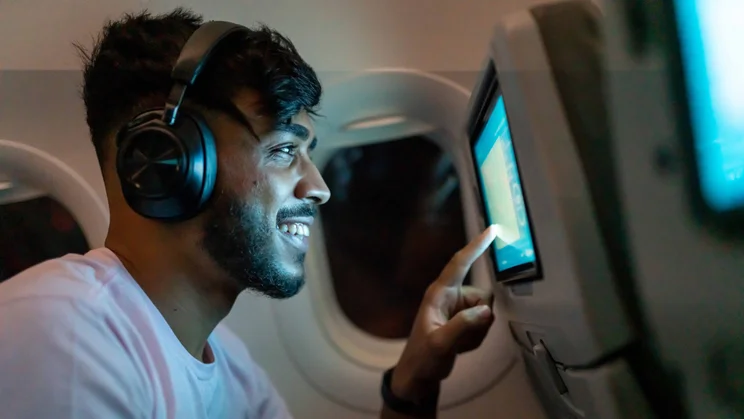
It may come as a surprise to learn that some airlines now offer dual in-flight entertainment options; you can choose to use either the seatback screen or a sister app on your own device. The good news is that this extended service is typically free for passengers.
United Airlines offers United Private Screening, allowing you to watch movies and TV shows via the app. On newer planes, United even allows Bluetooth headphones to connect directly to the seatback screen.
American Airlines also provides free streaming of movies and Apple TV+ via seatback screens and on its app on Wi-Fi-equipped flights. Ditto Delta Air Lines, with Delta Studio. Check before you fly.
If you’re flying an airline or route that doesn’t offer such convenience, then a Bluetooth transmitter is the best solution. These pocket-sized gadgets plug into the aeroplane’s audio jack and transmit wirelessly to your headphones.

The UP Travel (£99), a pocket-sized DAC from IFi, is one such. Plug this diminutive gizmo into an aeroplane’s headphone jack, and you’ll be able to connect wirelessly to two Bluetooth headphones.
Twelve South’s AirFly Pro 2 Deluxe (£70) lacks the Hi-Fi credentials of that option but serves the same purpose, and comes with an airline adapter as part of the package. If you don’t need the adapter, you can save yourself £10 by buying the AirFly Pro 2 (£60).
If you’re looking to upgrade your headphones before a holiday, consider the latest releases from Bowers & Wilkins and JBL.

The Bowers & Wilkins Pi8 come with a multi-talented charging case, which doesn’t just recharge your buds, but can also convert analogue signals to digital signals and transmit them wirelessly at up to 24-bit/96kHz, via aptX Adaptive Low Latency.
Use the supplied USB-C to 3.5mm cable to plug the case into the aeroplane’s headphone jack, and automatically transmit audio wirelessly to your Pi8 wireless earbuds.
JBL’s Tour Pro 3 earbuds also offer this retransmission functionality, while the brand’s Tour One M3 over-ear headphones work with a Smart TX transmitter, which performs a similar function when connected to a source via either the supplied USB-C or 3.5mm analogue cable connectors.
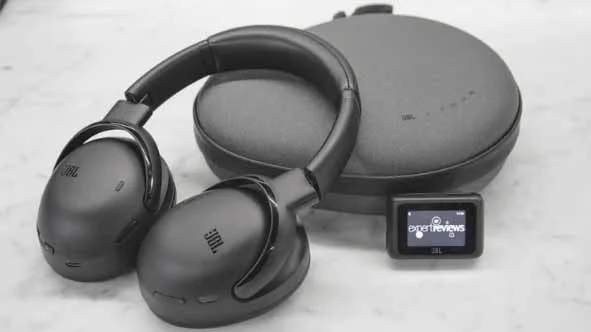
Wang is a fan and always packs a pocket-sized Bluetooth transmitter. ”The transmitter weighs almost nothing yet guarantees the same cordless freedom on routes where the airline has not upgraded.”
Travel expert LP Maurice, and CEO of cross-border bus booking service Busbud, is also an advocate of Bluetooth transmitters.
“A lot of people find out too late that their wireless headphones do not always work well with the built-in screens on planes,” he told me.
“Most older systems still use the two-prong audio jack. To avoid fiddling with the free headsets that can break or not fit well, it helps to pack a small Bluetooth transmitter. These pocket-size gadgets plug into the seat’s audio port and let you pair your own wireless headphones in seconds.”
Maurice also suggests keeping a pair of inexpensive earbuds in your travel bag as backup. “Many travellers forget that some airlines still sell adapters onboard, but they are not always available and cost more than at home. Keeping a cheap pair of headphones in your bag can save you the frustration of losing sound halfway through a movie.”
For long-haul flights, make sure your headphones and phone are fully charged, he adds, or pack a power bank. Increasingly, aeroplane seats will offer USB charging, so make sure you have an appropriate cable to hand to take advantage.
In praise of noise cancellation
Perhaps the greatest gift modern headphones offer to the frequent flier is active noise cancellation (ANC). By using outward-facing microphones to detect ambient sound and producing an inverse wave to cancel it out, noise-cancelling headphones can dramatically reduce engine rumble and cabin noise. Noise cancellation doesn’t just make movies and music sound better; it also reduces the fatigue of travel.
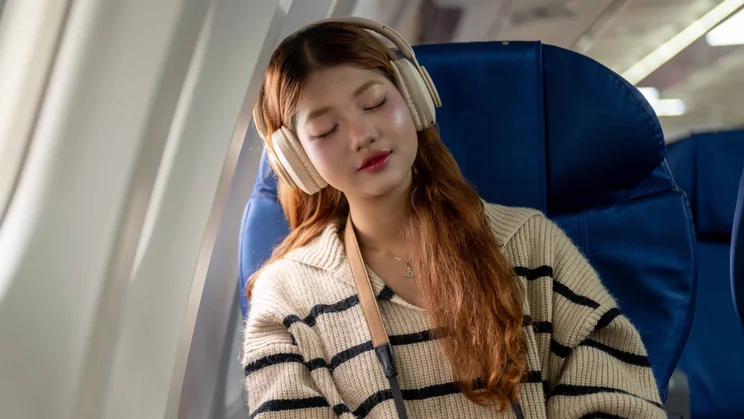
Finally, be sure to check out the audio selections available on your flight. Not only are you certain to find the entire oeuvre of Ed Sheeran, but there are also likely to be some ambient wellness options there, too. Just the thing if you want to drift off after take-off.

